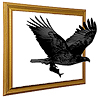We are all stewards. Windows on Evolution helps convey how our role as stewards includes protecting the sensitively-tuned relationships among species and between them and their environment. It is our job to recognize the degree to which we influence those relationships through policies we endorse and personal decisions we make.
In discussions it may help to consider how your view of human evolution compares with that of fellow stewards. In the U.S., for example, a 2012 Gallup Poll found that 15 percent held the view that humans evolved without divine intervention, 32 percent held the view that humans evolved with God's guidance, and 46 percent held the view that God created humans in our present form at one time within the last 10,000 years. Viewpoints inevitably vary. What is essential, however, is caring about other species and their relationships and protecting them.
It may also help to consider how your view of evolution might compare with that of tomorrow's stewards. German artist Bernd Pöppelmann reminds us that children will be considering our sins as stewards and how fast they will need to scramble to try to overcome them so their children will not be held back by barren soil and an imbalance between human life and that of other species.
 Science Art-Nature .presents:
Science Art-Nature .presents:
 Science Art-Nature .presents:
Science Art-Nature .presents: